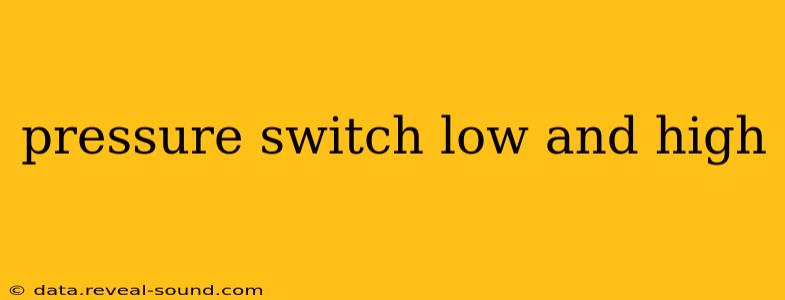Pressure switches are essential components in various systems, from water pumps to air compressors, ensuring safe and efficient operation. They automatically turn the system on and off based on pressure levels. Understanding how these switches work, and specifically their high and low settings, is crucial for maintaining optimal performance and preventing damage. This guide will delve into the intricacies of pressure switch high and low settings, answering common questions and providing valuable insights.
What is a Pressure Switch?
A pressure switch is a simple yet vital electromechanical device. It's essentially a pressure-sensitive switch that opens or closes an electrical circuit based on the pressure within a system. When the pressure reaches a predetermined low setting, the switch closes, activating the system (e.g., starting a pump). Conversely, when the pressure reaches a predetermined high setting, the switch opens, deactivating the system (e.g., stopping the pump). This cyclical operation ensures the system maintains the desired pressure range.
How Do Pressure Switch High and Low Settings Work?
The high and low pressure settings are adjustable, usually via two screws or dials located on the pressure switch itself. These settings define the pressure thresholds that trigger the switch's on and off actions.
-
Low Pressure Setting (Cut-in): This setting determines the pressure at which the system activates. When the pressure drops below this point, the switch closes, initiating the system's operation.
-
High Pressure Setting (Cut-out): This setting determines the pressure at which the system deactivates. When the pressure rises above this point, the switch opens, stopping the system's operation.
The difference between these two settings is called the differential pressure or pressure switch range. A larger differential means the system runs for longer periods before shutting off, while a smaller differential leads to shorter cycles.
What is the Differential Pressure?
Understanding Differential Pressure
The differential pressure, sometimes called the "pump-up" pressure, refers to the difference between the high (cut-out) and low (cut-in) pressure settings. This value dictates how much pressure the system builds up before shutting off. A larger differential means the system operates under pressure for a longer period before cycling off. A smaller differential results in shorter operational cycles. Choosing the appropriate differential pressure depends on the application and the system's requirements.
How to Adjust Pressure Switch High and Low Settings?
Adjusting the pressure switch settings requires caution. Always consult the manufacturer's instructions for your specific model. Improper adjustment can lead to system malfunction or damage. Generally, adjustment involves tightening or loosening the respective screws for high and low settings. Using a pressure gauge to monitor the pressure during adjustment is recommended for accurate settings.
What Happens if My Pressure Switch High Setting is Too High?
If the high pressure setting is too high, the system might operate under excessive pressure for extended periods. This can lead to premature wear and tear on components, potential system failure, and even safety hazards depending on the application (e.g., a burst water pipe).
What Happens if My Pressure Switch Low Setting is Too Low?
Conversely, if the low pressure setting is too low, the system may cycle on and off too frequently. This "short-cycling" can place excessive strain on the system's components, reducing their lifespan and leading to increased energy consumption.
How Do I Know What My Pressure Switch Settings Should Be?
The ideal pressure switch settings depend on the specific application and the system's components. Consult the manufacturer's specifications for the system's pump, tank, and other related equipment. A qualified technician can also help determine the optimal settings for your particular system.
Troubleshooting Pressure Switch Issues
If your pressure switch is malfunctioning, several issues could be at play, ranging from faulty settings to mechanical problems within the switch itself. Troubleshooting might require checking for leaks, ensuring proper electrical connections, or examining the switch for any signs of damage or wear.
This comprehensive guide provides a solid understanding of pressure switch high and low settings. Remember, proper adjustment and regular maintenance are key to ensuring the longevity and safe operation of any system that uses a pressure switch. Always prioritize safety and consult with professionals when necessary.
